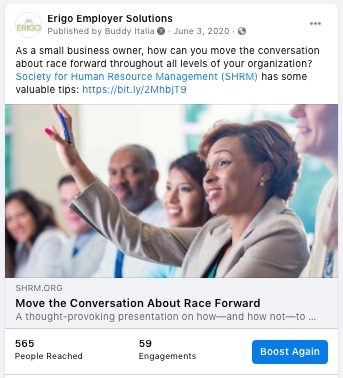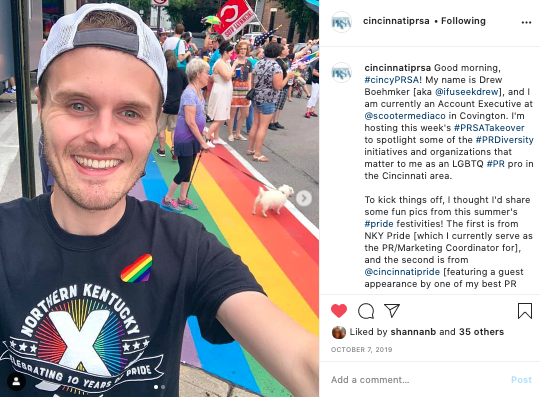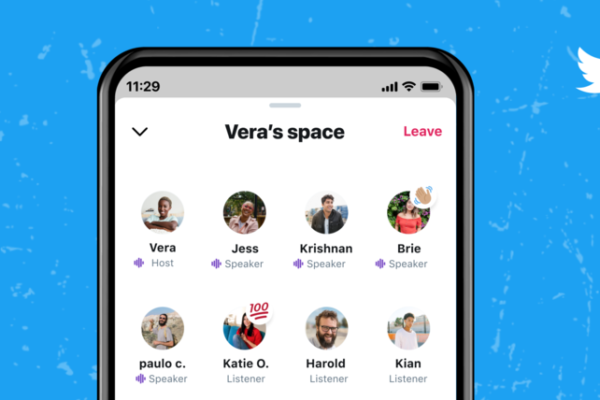Words matter. Specifically, the tone and sensitivity your brand displays when it comes to matters of diversity and inclusion can position your organization as a welcome place for audiences of all types. However, when these issues are not addressed sensitively, they can lead to public relations nightmares — especially on social media, where an organization can suddenly find itself in the midst of a crisis following a single errant post. (The University of Missouri’s athletics department found itself in such a situation with a poorly-conceived tweet as part of the #NCAAInclusion campaign in 2019). How can you be proactive and ensure your organization’s social media channels are welcoming for followers from all walks of life? Here are five strategies to make your social media content more inclusive:
1. Be Intentional When Selecting Stock Images

One of the easiest ways to make your social channels more inclusive is to be more intentional about the images you choose to share on your platforms. If your brand primarily relies on stock photos to accompany social media posts, sites like Pexels and Pixabay are not only free but also offer a wealth of images that speak to more diverse populations.
On the other hand, if your social posts typically feature photos celebrating company culture and events, whenever possible you should make it a point to utilize images that capture the true range of diversity in your company. This doesn’t just help to communicate your brand’s commitment to inclusion — it also means potential employees who find your social channels are more likely to apply if they see people who look like them are part of your company’s culture.
2. Watch Your Words
In 2021, social media pros do not have the luxury of saying “I didn’t know” as an excuse for using incorrect or insensitive terms. Make sure you’re staying up-to-date on the latest changes to the AP Stylebook to ensure your social posts are using the proper terms when referring to diverse populations; if you’re ever unsure or hesitant, it’s always best to double-check.
A great way to make sure your social copy is as considerate as possible is to use alex, a free online tool that helps you find gender-favoring, polarizing, race-related, religion inconsiderate, and other unequal phrases in your writing. Using the tool couldn’t be easier; you just copy and paste the text that you’d like to check, and alex will alert you to any potential issues.
3. Celebrate Appropriately
Most social media managers are aware of “fun” holidays that can help spice up your social media calendar — but have you ever thought about using your social media channels to commemorate days of importance to diversity and inclusion movements? For example, 2020 saw an uptick in brands recognizing and celebrating Juneteenth, using the holiday as a way to call attention to the historical significance of the date.
In recognition of #Juneteenth, we’re helping broaden the dialogue on race, justice & equality – and moving people from reflection to action. https://t.co/niOvjcvoIH
— Procter & Gamble (@ProcterGamble) June 19, 2020
Not sure which D&I holidays make sense for your company to celebrate on social media? Here’s a helpful list to help you get started.
4. Always Include Alt Text
Almost all social media platforms now give users the ability to add alt text (short for “alternative text”) to any social media posts with visuals — and if your organization isn’t currently using this feature, it’s time to start.
Alt text is a way to make your social media profiles compliant with the Americans with Disabilities Act (ADA), allowing users with screen readers or other assistive devices to easily navigate your pages. Alt text should be short, descriptive, and accurate.
Learn more about alt text by reading our primer on why alt text is so important, then check out our how-to guide for utilizing alt text on your social media profiles and pages.
5. Give People a Voice via Instagram Takeovers

At the heart of diversity and inclusion is the idea of ensuring everyone has a voice; what better way to ensure that diverse populations are being heard than by using your social media channels to amplify their message?
If your business is on Instagram, consider inviting employees to “take over” the platform for a day (or even a few days) and allow them to share their experiences of working at your company. For example, does your business support local Pride marches? If so, allow an LGBTQ+ employee to take over the platform and allow your social media followers to see the event “through their eyes.”
Whether you follow a few of these tips or all of them, a little effort can go a long way toward making your social media channels more diverse and inclusive.
Looking for more ideas on how to integrate diversity and inclusion into your social media efforts? Check out “The Dos and Dont’s of Cause-Related Marketing,” as well as some best practices and ideas for celebrating Pride in your PR campaigns.


